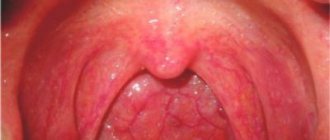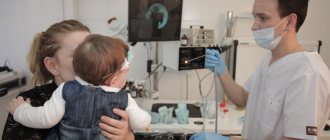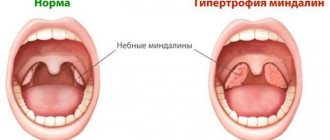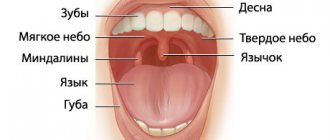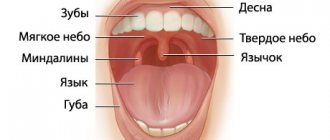Causes and symptoms of the disease
Chronic inflammation of the tonsils can be caused by:
- untreated infectious diseases (most often it is a sore throat, so it is necessary to treat a sore throat in a timely and correct manner);
- the presence of other foci of inflammation in the body (for example, chronic sinusitis);
- diseases of the oral cavity (caries, stomatitis, periodontal disease);
- deviated nasal septum;
- heredity;
- reduced immunity;
- stress and nervous tension.
Any chronic disease is characterized by alternating stages of exacerbation and remission. During an exacerbation, the patient complains of pain, soreness, a feeling of a lump in the throat, as well as bad breath (which indicates the presence of purulent plugs in the lacunae of the tonsils). The body temperature rises to 37.5℃. It is very difficult to stay in this state for a long time. But you still need to study, work, lead a normal lifestyle. Only treatment by an otolaryngologist will help alleviate the patient’s condition and get rid of unpleasant symptoms.
What effect does this procedure give?
When completing a full course, which consists of 5-10 procedures, washing the lacunae of the tonsils with the device helps:
- complete cleansing of the oral cavity from pathogenic bacteria and their metabolic products;
- creating the necessary conditions for the penetration of drugs into the affected area;
- improving blood supply and cellular nutrition of tonsil tissue;
- reducing the inflammatory process;
- improving local immunity.
Remove or treat?
Among experienced patients, there are many stories from the series: “Previously, the problem was solved simply - you just need to remove the tonsils, and life will sparkle with bright colors.” Many patients purposefully come to an ENT doctor with a request to get rid of tonsils once and for all. However, many do not understand that by removing such an important organ of the immune system, a person is deprived of a natural barrier against infection. Yes, the problem of tonsillitis will disappear, but other diseases, for example, of the respiratory tract, will take their place. Bacteria and viruses will be able to freely enter the body, causing inflammation of other human organs and systems.
To remove tonsils according to indications, you need:
- often have a sore throat (more than four times a year);
- have a history of peritonsillar abscess;
- have poor rheumatic test scores;
- diagnose complications in your heart, kidneys or joints.
If there are no direct indications for removal, you need to contact an otolaryngologist to prescribe competent complex therapy, which will significantly increase the duration of remission and reduce the number of exacerbations.
One of the most effective procedures for treating tonsillitis, which avoids removal, is washing the palatine tonsils.
Why do you need to rinse your tonsils?
The palatine tonsils are an organ of the human immune system. They are located at the very entrance to the pharynx on both sides. Outwardly, they resemble almonds. This similarity gave this organ its name. The tonsils consist of a large number of winding canals - crypts. On the surface of the tonsils there are small depressions - lacunae. It is in them that tonsillitis plugs accumulate, which are removed by washing.
Our tonsils act like a filter. They filter everything that enters the oral cavity from outside. And if infectious flora gets on the surface of the tonsils, they begin to produce lymphocytes - cells of the immune system that begin to fight the “enemy”.
If the body's defenses are not enough to cope with viruses and bacteria, an inflammatory process (chronic tonsillitis) starts in the palatine tonsils. In the gaps, pathogenic microflora is activated, the remains of bacterial activity and dead leukocytes accumulate. This entire “mixture” is compressed and turns into white-yellow plugs on the tonsils, which are noticeable upon examination and emit an unpleasant odor. These plugs do not allow inflammation to subside, so sanitation of the tonsils is an important part of the treatment of chronic tonsillitis.
Often, rinsing is the only way to preserve the tonsils and avoid their removal.
Benefits of the procedure
There are two ways to rinse the tonsils: using a syringe or using the vacuum method using the Tonzillor apparatus. The ENT doctor decides how to rinse, based on the patient’s condition and his physiological characteristics.
The washing procedure has a number of undeniable advantages:
- persistent therapeutic effect (if you rinse your throat in courses, you can achieve long-term remission, and the symptoms of tonsillitis will not remind you of themselves for a long time);
- During the procedure, antiseptics and local antibacterial drugs are used, which act exclusively on the inflamed area, unlike conventional antibiotics taken orally;
- no allergic reactions;
- Children and pregnant women can wash their tonsils.
How often do rinses need to be done? For long-lasting results, otorhinolaryngologists recommend performing the procedure several times a year.
Friends! Timely and correct treatment will ensure you a speedy recovery!
Before washing your tonsils, you must stop eating at least an hour before visiting the doctor. After the session you need to abstain from food for a couple of hours.
Complex therapy for chronic tonsillitis usually includes ten rinsing sessions, which are carried out daily or every other day.
Contraindications to washing are: cancer, tuberculosis, acute infectious diseases, mental disorders, hypertension.
Regular rinsing allows you to avoid tonsillectomy (surgery to remove tonsils) and significantly increase the period of remission.
Contraindications
It is also necessary to take into account a number of contraindications to such a procedure. These include:
- ENT diseases in the acute stage (including acute tonsillitis);
- influenza, ARVI and other viral diseases;
- acute form of tuberculosis;
- negative reaction of the body to ozone;
- malignant neoplasms of any location;
- hypertension 3 degrees;
- blood clotting disorder;
- first trimester and last month of pregnancy.
Rinsing the tonsils with a syringe
This method is the most common and accessible. It will be offered to you at the local clinic. The essence of the technique is as follows: an ENT doctor, using a needle-free syringe, injects an antiseptic drug into the lacunae of the tonsils, which, together with the purulent masses from the lacunae, is washed into the patient’s oral cavity. The patient spits the solution into a special tray, and the ENT doctor repeats the procedure. Upon completion, the tonsils are lubricated with Lugol's solution.
The disadvantage of the procedure is that it is not possible to thoroughly rinse the lacunae, since the openings in the tonsils are very narrow. This rinsing helps with minor purulent accumulations.
The manipulation should be carried out by an experienced ENT doctor. Inept movements can injure the walls of the tonsils, which will only worsen the patient’s condition.
Recently, in modern ENT clinics this technique is used less and less, mainly in cases where the patient has a pronounced gag reflex.
It is much more effective to rinse the tonsils using a vacuum method using the Tonsillor apparatus.
Syringes for washing tonsils
Nowadays, a huge number of people suffer from throat diseases. If not treated in a timely manner, the disease can become chronic, so it is recommended to consult a doctor. One of the ways to treat a throat is to rinse the tonsils at home with a syringe . The method, of course, is unpleasant, but effective; it makes it possible not only to remove the signs of the disease, but also to completely cure the disease.
Main purpose
A syringe for intralarynx infusions and lavages is used by specialists in every ENT office. It serves to treat the tonsils with a special antiseptic solution, which is pre-filled with this device. It is difficult to do such procedures on your own, but it is possible. Such manipulations at home must be carried out carefully so as not to provoke injury or pain.
After the first procedure, positive results will be visible. Do it every day until the unpleasant symptoms disappear. Before using a syringe to rinse the tonsils yourself, it is recommended to consult with your doctor. In addition, you need to choose the right syringe and learn how to use it, as well as know where to buy a syringe for washing the tonsils .
Kinds
The syringe for washing the tonsils comes in two and five cubic meters. Syringe parts are made from different materials. Nozzles can be made of stainless steel or brass. Brass is often used to make metal parts of instruments. The liquid cylinder is most often made of glass, less often - of plastic. All seals in the instrument are made of silicone rubber. Nozzles can have a cylindrical or tapered end, as well as various degrees of curvature. buy a syringe for washing either disposable or reusable.
General information about the procedure
A syringe for rinsing lacunae of the tonsils and tonsils in medical institutions is used with a special cannula, which is a long attachment with which you can accurately target the lacunae, and a curved needle. The nozzle is used to reach the lacunae, then an antiseptic solution is fed under pressure through a needle that should enter the lacunae. This promotes more accurate and complete cleansing, and also simplifies the procedure for treating the throat. When carrying out the procedure, you need to pay attention to the following points:
- the needle should not be thick;
- It is not allowed to swallow the solution.
Tool assembly
Rinsing the tonsils with a syringe at home involves preliminary preparation of the instrument. To do this, you must assemble it correctly, following the instructions:
- The sleeve is retracted along the handpiece tube, releasing the cannula.
- The cannula is tightly placed on the tip.
- The sleeve is passed through the tube and screwed onto the thread.
- Before use, the laryngeal syringe for washing the tonsils is checked for damage.
- The product is placed on the table surface, having previously laid a napkin.
- When replacing the ring, do not use sharp objects.
Solutions used
Rinsing the tonsils with a syringe, the video of which can be watched, involves the use of any antiseptic agents. But all of them must be non-toxic, not cause allergic reactions, as well as burns of the oral epithelium, have a liquid state and a wide spectrum of action.
Often, a solution of Furacilin or Miramistin is poured into a syringe for intralarynx rinsing . Chlorhexidine can also be used. Before starting the procedure, it is recommended to bring the solution to room temperature and shake well. Decoctions of oak bark and sage or a salt solution are often used.
Algorithm for further actions
After the laryngeal syringe for lavage is assembled, an antiseptic solution is drawn into it. Before the procedure, the tonsils are treated with an anesthetic, which is released in the form of an aerosol, to prevent the development of pain and relieve the gag reflex. The syringe nozzle is inserted into the lacuna and treated with a medicinal agent under strong pressure. The solution is then immediately spat out.
Possible consequences
Using a syringe for rinsing cavities , you must do the procedure very carefully, as you can injure the tonsils. The liquid after washing the tonsils must be spat out, because pathogens and particles of pus will be present there. This procedure is recommended to be carried out in courses, the duration of which will be determined by the attending physician. Using a syringe for rinsing lacunae of the tonsils , one cannot talk about a 100% recovery result, since each case is individual and should be considered by an experienced physician.
Place of purchase and cost of the syringe
You can buy a syringe for washing tonsils at a pharmacy . The cost of the tool is high. The price of a two-gram reusable syringe is about five hundred rubles, and a five-gram one is six hundred rubles. You can also buy a disposable laryngeal syringe for rinsing , in which case it is thrown away after use. Its cost is slightly lower.
Disinfection of a reusable syringe
A syringe for washing tonsils (you can buy it at any pharmacy) after use must be disinfected by boiling for half an hour in a completely disassembled form. It can also be washed with a special detergent for five minutes. After this, the syringe for washing lacunae, which is not difficult to buy, with clean water and dry with hot air.
Vacuum washing method
The vacuum method of rinsing using the Tonsillor apparatus is the most modern way to rinse the lacunae of the tonsils.
In simple terms, the nozzle of the Tonsillor device works on the principle of a vacuum cleaner. It is attached to the tonsil, the device creates negative pressure. The washing solution, passing through the lacunae of the tonsils, washes out their pathogenic contents, which, together with the waste solution, are sucked into a special cup of the nozzle. That is, the solution is used and passes through the tonsils only once, which confirms the sterility of the manipulation. Before washing, topical anesthesia of the tonsils is performed with lidocaine solution.
Despite the effectiveness of vacuum washing, this method is not without its drawbacks:
- it happens that the edges of the nozzle can injure the surface of the tonsil;
- The walls of the cup, where the washing solution that has passed through the tonsils is evacuated, is opaque, and the doctor cannot see whether the tonsils have been completely washed. As a result, the ENT doctor has to carry out additional procedures to certainly clear the lacunae.
A reasonable question arises: “Is washing the tonsils always associated with some risks?” No! There is another way to wash the tonsils - safe, effective and non-traumatic. This is the use of an improved Tonsillor attachment.
How to get to the procedure
To sign up for lavage of lacunae, you first need to undergo a high-quality examination, which can only be carried out by an experienced ENT specialist:
- visual inspection of the tonsils;
— collection of information about the course of the disease;
- tests;
Only after taking these necessary measures does the doctor decide whether the patient needs this medical procedure, since it has contraindications.
Where to get tonsil treatment
The Elena Malysheva Medical Center offers washing of the lacunae of the palatine tonsils, the cost of the service will not hit your pocket.
Doctors with high qualifications and extensive experience will conduct all the necessary studies before and after the procedures. They will determine whether the patient has contraindications and prescribe the required number of rinses to achieve the maximum therapeutic effect.
All manipulations with the tonsils occur only with the help of the most modern equipment that meets all international quality standards.
If you choose the Elena Malysheva Medical Center, then you are turning to real professionals.
Rinsing with a modified Tonsillor nozzle
This method of washing will not be offered to you in any of the clinics in Moscow, except for the ENT Clinic of Doctor Zaitsev! An improved, modified attachment for the Tonsillor apparatus was developed by the founder of the ENT clinic, Vladimir Mikhailovich Zaitsev, together with his colleagues. The operating principle of the new nozzle is absolutely the same as that of the classic nozzle. The difference is in its structure:
- the improved “Tonsillor” nozzle creates greater negative pressure, due to which rinsing the tonsils is much more effective and of better quality;
- the edges of the nozzle in contact with the tonsils do not cause damage or microtrauma;
- The cup of the nozzle into which the washing solution with the purulent contents of the lacunae is sucked in is transparent, and the doctor immediately sees at what point the procedure can be stopped. Thus, the patient does not undergo unnecessary manipulations.
- The size of the nozzle allows washing even for children.
It is necessary to rinse the tonsils only with the participation of an otolaryngologist. We do not recommend self-medication!
In order to forget about the symptoms of chronic tonsillitis for a long time, it is necessary to undergo a full comprehensive course of treatment of chronic inflammation, including, in addition to rinsing, drug therapy and physiotherapeutic procedures. This is the only way to preserve the tonsils and achieve stable remission!
What is this procedure?
Tonsilor is a special device that came into the arsenal of otorhinolaryngologists several years ago, but has already proven its undeniable effectiveness. The method is based on the vacuum effect on the pathological contents of the lacunae of the tonsils. Tonsilor rinsing can be carried out even in an outpatient clinic; it is enough that the doctor has the necessary equipment and sufficient experience.
To be completely confident in safety and guaranteed results, make an appointment at a diagnostic and treatment center in Moscow. Our specialists will cope with the task quickly and efficiently!
Our clinic constantly hosts promotions
What are tonsils, structural features
The immune system consists of many components. They participate in the formation of the body’s immune response to pathogenic agents when attempting to introduce them. The tonsils are considered an important part of it. They are accumulations of lymphoid tissue. The tonsils are located in the mucous membrane lining the pharynx. Formations become the first filter on the path of infection into the body.
Together with other accumulations of lymphoid tissue, they form the pharyngeal ring. Tonsils have a complex structure. They are pierced by winding deep channels called crypts. Branching reaches the third or even fourth order. Their number is usually from 16 to 18 pieces. The epithelium covering the walls of the crypts is associated with lymphoid tissue over a large area.
These formations are most developed in the area of the upper pole of the tonsil. In their lumen, desquamated epithelial cells, food debris, leukocytes, and lymphocytes accumulate. Bacteria actively multiply in this environment. This structure promotes the development of chronic inflammatory processes inside the crypts.
Methods for treating inflammation of the tonsils
Chronic tonsillitis is usually treated using conservative and surgical methods, which are used only as a last resort.
The following types of therapy are used:
- antibiotic therapy prescribed by otolaryngologists taking into account the sensitivity of bacteria; treating the throat with antiseptic solutions (“Octenisept”, “Miramistin” and others); antihistamines to relieve swelling of the mucous membrane; immunomodulators to stimulate the immune system; painkillers.
The patient must strictly follow a diet. Exclude solid foods, cold or hot dishes and drinks, alcohol, soda.
What to do if your throat constantly hurts? Is this an infection?
No, persistent sore throat is most often caused by non-infectious causes. The most common cause is acid from the stomach entering the back of the throat through the esophagus. This condition is medically called gastroesophageal, or extraesophageal, reflux. This is a very common illness that can occur without abdominal pain or heartburn. If heartburn occurs constantly and your throat often hurts, then the connection between these events is obvious and you need to deal with this particular problem, and not try to cure your throat.
Why are purulent plugs in the throat dangerous?
If traffic jams and inflammation are not eliminated, the disease can affect the heart and kidneys. Inflammation can affect joints and skin. When pyogenic bacteria penetrate from the throat into the blood, it can become infected and spread the infection to other tissues and organs. There are also known cases of replacement of lymphatic tissues in the palatine tonsils with scar tissue.
Common complications are neck cellulitis and peritonsillar abscess. In the first case, infectious inflammation of the subcutaneous tissue of the neck occurs and, in the absence of surgical treatment, there is a high probability of death. In the second case, the inflammation spreads to the fiber surrounding the tonsils and causes an acute inflammatory process.


